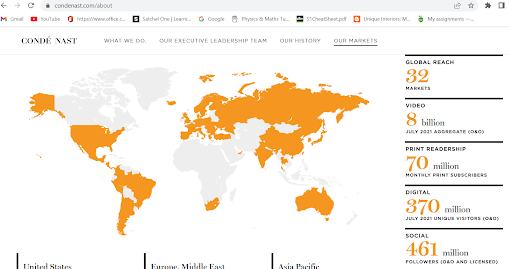Industrial context
A brief history/timeline of magazines
17th century - After the printing press became prevalent in Europe, publishers began to create what would now be known as a magazine. Publishers would create these in the form of brochures and pamphlets and then realised that irregular publication took too much time and energy so they shifted to publishing copies at regular intervals for regular readers with specific interests. Magazines were regarded as being the middle ground between books and newspapers.
Between 1663-1668, German theologist Johann Rist published the first true magazine which was titled “Erbauliche Monaths-Unterredungen” (Edifying Monthly Discussions) which inspired other literary journals throughout Europe.
18th century - With the arrival of the 18th century, there was in increase in literacy amongst women affecting the literary world as a whole and inspiring many female writers to publish novels for female readers. The first magazine targeted towards women was published in 1693. Some magazines drew a large number of female readers so they eventually added female publications of their magazines.
In 1741, American magazines debuted and neither of the first two magazines lasted long due to audiences not having the leisure time to read, high costs of publishing and expensive distribution systems. Regardless of this, magazine began flourishing nearer the end of the 18th century.
19th century - During the 1830s, publishers began taking advantage of the decline in cost of printing and publication and started producing less expensive magazines targetting wider audiences. Not only did this transform the magazine style but magazines were no longer for the elite class and they reached an expanded audience. They were also more centred around amusement around this time. One of the first American women’s magazines was “Godey’s Lady’s Book” which was printed between 1830-1898, employing nearly 150 women to reach female readers. Most publications were eventually struggling to achieve widespread circulation because of how expensive magazines were at the time. This changed when one publisher decided to sell his magazine for half the price in 1893 and, for the first time, magazines were sold for less than they cost to produce. Because of the greater circulation, magazines now had space for advertising.
The Saturday Evening Post was the first truly successful mass circulation magazine in the US and it was in production between 1821-1969 until a new owner transformed the brand to focus on health and medical breakthroughs. This publication was the first to put artwork on its cover.
20th century - When magazines were first being published, there was a larger focus on publishers' interests in literature which is why there were little to no adverts. By 1900, advertising became a crucial part of magazines as they would help reach a wider audience. Magazines responded by increasing advertising rates which in turn increased their profitability.
At the turn of the century, advertising became a norm for magazines and this was especially the case for many women's magazines where advertisements accounted for nearly half of all the content.
With the arrival of the new century, new types of magazines were developed such as news, business and picture magazines which came to dominate the industry and attract vast readership.
21st century - During the late 20th and early 21st century, online technology was in its advent and newspaper and magazine publishers had to rethink how to structure their products to reach an online market.
Contemporary context - the major players
Condé Nast's Markets
Hearst's markets
Dotdash Meredith
This is the only company the three leading magazine companies that didn't disclose their readership on any platform.
How do magazine companies finance, distribute and exchange their products?Financing:
From an article written in 2020, the main ways magazine companies finance their products is through:
- Print subscriptions - print subscribers are usually long term fans of the magazine they are subscribed to and therefore would be less fickle than other fans of the magazine
- Print advertising - print magazines allow for more space for print advertisers to work with
- Online subscriptions - online subscriptions can be accessed on multiple devices, allowing for an "array of ways to connect with the magazines subscribers"
- Digital advertising - great way to boost revenue, could be done through third party services or a third party service.
- Sponsorships and sponsored content - this is a form of advertising that means that a single partner would buy out a whole section, piece or period of time, meaning there would be amazing revenue margins and less sales work for the advertisers.
- Events and conferences - great promotional tool and engaging for the audience
- Live streaming - can monetize live streams and this can be a great way to attend a real-time event with more safety and hygiene (due to covid restrictions)
- Video, podcasts & more new media - each platform has a different unique monetizing strategy
Distribution:
- Print publication in retail
- ecommerce websites
- Social media
I found that the wasn't any clear information on how magazine companies exchange their products so I didn't include it
References: https://www.mazsystems.com/en/blog/magazines-make-money, https://www.upperdeckblog.com/2012/03/how-to-open-a-trading-card-shop-with-magazine-exchange/, https://www.dialogue.agency/blog/5-ways-to-master-a-contract-magazine-distribution-strategy, https://www.encyclopedia.com/media/encyclopedias-almanacs-transcripts-and-maps/magazine-industry-production-process
How do audiences access them?
Audiences access magazines through:
- Print copies in retail
- Digital copies if they have a subscriptions
- Some free articles online
- Social media
A brief history/timeline of Hearst magazines
Reference: https://www.hearst.com/history, https://www.companieshistory.com/hearst/, https://www.hearst.co.uk/, https://rarebit.org/?studio=international-film-service, https://www.goodhousekeeping.com/institute/about-the-institute/a17940/good-housekeeping-institute-timeline/
The beginning of the Hearst Corporation
1800s - On March 4th 1887, William Rudolph Hearst placed his name as "Proprietor" as the masthead of the San Francisco Examiner. This was when he founded the Hearst Corporation, which has grown from being a single newspaper to a now mass media conglomerate.
1896 - Richard F. Outcault, an American cartoonist, developed "The Yellow Kid" with the encouragement of William Rudolph Hearst. "The Yellow Kid" transformed into a comic strip from initially just being a gag panel and was responsible for not only launching American Humorist* comic supplements for the Hearst but also for coining the term "Yellow Journalism", which refers to an emphasis on sensationalised news over facts to attract attention and increase circulation and readership to thereby increase sales of newspapers.
Comics, news and film
1900s - 1910s - In 1911, Hearst gained acquisition to Good Housekeeping, an American women's lifestyle magazine. In 1913 Hearst acquired Harper's BAZAAR, a renowned American women's fashion magazine and the first newsreel was introduced, leading to the creation of Hearst Metrotone News. Following the success of Hearst Metrotone News, Hearst International Film Service which was an animation studio formed in 1915, allowing some of their corporation's comic strip characters to be adapted into movie stars.
Harper's BAZAAR
1930s - 1960s - 1930 - Harper's BAZAAR became one of the first fashion magazines to do a shoot on location and to feature a model in motion.
1940 - the Editor-in-Chief of this magazine, Carmel Snow, chose to feature a photograph on the front cover, making it the first time for this magazine to have an image instead of art or illustrations on the cover.
1952 - Hearst's Television's WBAL-TV Baltimore became one of the first stations to broadcast in colour. 1955 - Hearst Newspapers arranged the first cultural exchange between the United States of America and Russia, including interviews with Soviet leaders that led to a Pultizer Prize, an American award of achievement in magazines, journalism, literature etc.
1965 - Harper's BAZAAR became the first women's fashion magazine to feature a man, actor Steve McQueen, on the front cover.
1980s - 1990s - 1981 - Hearst becomes a founding partner with ABC, the precursor of cable networks A&E and Lifetime.
1986 - Hearst acquired Esquire, an American men's magazine.
1990 - Hearst gains 20% interest in ESPN, an American international cable sports channel.
1994 - Hearst and France's Marie Claire Album launch the American edition of Marie Claire, an international monthly magazine.
2000s - 2010s - 2000 - O, The Oprah Magazine, collaboration with Oprah Winfrey's Harpo Entertainment Group was published and regarded as one of the most successful magazine startups in history. Hearst Television became the first large television group to commit to a minimum amount of daily candidate discourse-focused coverage of election campaigns and this pledge became a part of the company's "Commitment" remit that is still continued on today.
2001 - The corporation became the first to commit to a major building project in NYC after the events of 9/11 - The Hearst Tower. The Hearst Tower is architect Lord Norman Foster's first US skyscraper.
2002 - ESPN agreed to multimedia NBA coverage, being the first network to television all four major American professional sports (NFL, NHL, MLB, NBA)
2004 - The conglomerate gained acquisition of Zynx Health Incorporate, the leading supplier of evidence-based medicine content to more than 500 hospitals across the US.
2005 - The four of the following companies and institutes, Hearst, American Land Conservancy, California Rangeland Trust and the State of California, form one of the largest conservation easements in history (82,000 acres) in San Simeon, California and ESPN became one of the first networks in cable television history in the US to pass the 90 million subscriber mark.
2007 - The first local HD news programming in Sacramento, Boston and Kansas City (KCRA-TV, WCVB-TV, KMBC-TV) was launched by Hearst.
2008 - King Features a digital comics platform, Comics Kingdom, which was a first in that media platform. Esquire featured an electronic "paper" cover that allowed words and images to scroll across it, a first for magazines, to commemorate 75 years of the magazine.
2009 - Hearst's Seattle Post-Intelligencer becomes the first major daily newspaper to transition to an all-digital platform. Good Housekeeping launched the Green Good Housekeeping Seal, an environmental extension of the original Seal. This was significant as many companies didn't consider sustainability at the time and the Green Good Housekeeping Seal provided standards to evaluate products based on their measurable environmental impact.
2010 - Hearst became the first magazine publisher to make all of it's subsidiaries available to read on every major tablet device.
2011 - Hearst acquired nearly 100 magazines in 14 countries from Lagardère, an international media company operating in over 40 countries, resulting in it becoming one of the largest monthly magazine publishers in the world and the largest monthly publisher in America. The first live streaming cables available in the US on mobile devices and applications were launched by Hearst and they were The WatchESPN app for iPad, iPhone and iPod allowing ESPN, ESPN2, ESPNU and ESPN3.com to be accessed through mobile.
2018 - Hearst completed their agreement and transaction with Rodale, Inc (which used to be an American publisher of health and wellness, magazines etc) to acquire the company's global health and wellness brands and these acquired brands now publish 62 print editions and 57 website editions in 31 countries. During 2018, Hearst also took full ownership of one of the biggest credit rating agencies, Fitch Ratings Inc., after initially acquiring 20% stake of the agency in 2006.
From this timeline we can see that the Hearst Corporation have been pioneers and trailblazers for many media outlets, products and trends and has maintained consistent and relevant throughout the longevity of it's existence.
*italicised words refer to the names of the companies and subsidiaries in the Hearst Corporation conglomerate
Note: I have only included a timeline of the events I found to be most significant.













